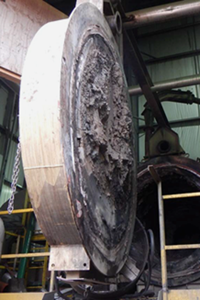Explosion in dryer system injured three workers
Date of incident: October 2014
Notice of incident number: 2014140710119
Employers: Mill machinery service company; Wood products manufacturer
Incident summary
During maintenance shutdown at a wood pellet plant, three workers employed by a mill machinery service company were working at the mill to clean the burner. The workers were standing at the opening of a burner door when an explosion occurred in the dryer system. The three workers were knocked backward by the force of the explosion and suffered burn injuries.
Investigation conclusions
Cause
- Flammable gases accumulated and exploded: An accumulation of flammable gases in a contained dryer system was exposed to high temperatures and oxygen, leading to an explosion. A fire or hot spot was present in the system, and with the burner door open, an in‑rush of oxygen occurred, resulting in an explosion that injured three workers.
Underlying factors
- Not following procedures to permit adequate cooling time: The mill’s written procedure for burner cleanout was not followed. The combustion air fan was turned off before the burner outlet cooled to 80°C. Also, the burner manufacturer’s instructions were not followed: the instructions require the combustion air fan to remain on for three hours before the burner door is opened. By not incorporating the manufacturer’s instructions, the mill’s procedures were not adequate to safely cool the dryer system. These two failures resulted in cleanup work being started in the combustion chamber while high temperatures were still present.
- No operator in the control room: The production superintendent told the day shift operator to assist with the cleanup, and the control room was left unattended. High temperatures developed within the system, and the day shift operator was not in a position to monitor or control them.
- Lack of effective coordination: The induced draft fan was shut down and locked out at the motor control centre switch by a contractor (a welder) without the knowledge of the production superintendent or the day shift operator. This resulted in temperatures rising in the system while workers were cleaning the burner. This fan shutdown should have been done in the control room by the control room operator, who could monitor when it was safe to do so, and then the group lockout should have been completed. Lack of coordination between the production superintendent, the lead hand, and the welder were factors in this incident, as well as the failure to effectively coordinate the control room operator’s duties.
2021-04-22 20:42:33

